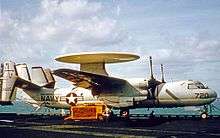VAW-122
Carrier Airborne Early Warning Squadron 122 (VAW-122) was an aviation unit of the United States Navy in service from 1 September 1967 to 31 March 1996. Originally nicknamed the "Hummer Gators"[1] and later as "Steeljaws" was a U.S. Atlantic Coast Carrier Airborne Early Warning Squadron stationed at NAS Norfolk. During its 30 years of existence, the squadron was deployed around the world and saw action from Vietnam to Desert Storm, conducting operations from the Arctic to the tropics.
| Carrier Airborne Early Warning Squadron 122 | |
|---|---|
_patch.png) VAW-122 Insignia | |
| Active | 1 April 1967 - 31 March 1996 |
| Country | United States |
| Branch | |
| Type | Airborne Early Warning |
| Part of | Carrier Air Wing 6 |
| Nickname(s) | "Steeljaws", "Hummer Gator" |
| Engagements | USS Liberty incident Vietnam War Operation Urgent Fury Operation Provide Comfort |
Squadron History
1960s
Originally equipped with the E-2A Hawkeye, VAW-122 was first on the scene, establishing communications and directing fighter coverage for the USS Liberty in the Mediterranean in June 1967 after the intelligence-gathering ship was attacked by Israeli aircraft and torpedo boats. During a 1968 deployment on board the USS America off Vietnam, VAW-122 crews assisted a VF-33 F-4 Phantom crew in downing a North Vietnamese MiG-21 fighter as well as controlling interdiction strikes against North Vietnam.[2]

1970s
After a 1970 deployment to the Mediterranean during the Jordanian crisis with CVW-7 on board the USS Independence, VAW-122 upgraded to the somewhat more capable E-2B. The squadron's next two deployments to the Mediterranean returned its crews to international crises—the 1973 Yom Kippur War and the 1974 Cyprus Crisis.[2]
In April 1975, VAW-122 upgraded to the definitive E-2C Hawkeye. In 1978, the squadron rejoined after a Pacific deployment embarked in USS Kitty Hawk with CVW-6 and over the next 13 years deployed to the Arabian Sea, Mediterranean, and North Atlantic on board the Independence and the USS Forrestal.[2]
1980s
In 1982 VAW 122 deployed on board USS Independence and provided support to operations in Beirut, Lebanon.[3] During the 1983 deployment, VAW-122 supported combat operations in Grenada and Lebanon, then on its last combat carrier deployment in 1991, supported Operation Provide Comfort over Iraq during and subsequent to Operation Desert Storm. Throughout its operational lifetime, VAW-122 participated in numerous cold-war, North Atlantic, Mediterranean, African, Indian Ocean, Eastern European, and Middle Eastern operations, supported several NASA Space Shuttle launches, and devised a variety of original operational tactics and procedures including ABCCC missions.[2]
1990s
VAW-122 made its first major counter-narcotic deployment as a squadron to the Caribbean and Central America in 1990, previously it had been smaller detachments of shorter duration beginning in 1983 with Operation Thunderbolt. In 1992 became permanently assigned to the role of counter-narcotic. By 1996, the unit had completed eight deployments in the Caribbean and Eastern Pacific areas, conducting some missions deep over South or Central America, and far into the Pacific Ocean—and was credited with the seizure of more than 16 metric tons of illegal drugs.[2]
VAW-122 was disestablished at NAS Norfolk on 31 March 1996. Its drug-interdiction mission and aircraft were assumed by VAW-77, stationed at NAS Atlanta.[2]
Deployments

Deployments of the squadron[1]
| Group | Dates | Location | |
|---|---|---|---|
| USS America | 1 April 1967 | 20 September 1967 | MED [note 1] |
| USS America | 10 April 1968 | 16 December 1968 | Vietnam |
| USS Independence | 8 July 1970 | 1 February 1971 | MED |
| USS Independence | 16 September 1971 | 15 March 1972 | MED |
| USS Independence | 21 June 1973 | 19 January 1974 | MED |
| USS Independence | 19 July 1974 | 31 January 1975 | MED |
| USS Kitty Hawk | 25 October 1977 | May 1978 | WESTPAC |
| USS Independence | 24 June 1979 | 14 December 1979 | MED |
| USS Independence | 19 November 1980 | 10 June 1981 | IO |
| USS Independence | 7 June 1982 | 21 December 1982 | MED |
| USS Independence | 18 October 1983 | 11 April 1984 | MED/N. ATLANTIC[note 2] |
| USS Independence | 16 October 1984 | 19 February 1985 | IO |
| USS Forrestal | 2 June 1986 | 10 November 1986 | MED |
| USS Forrestal | April 1988 | September 1988 | MED |
| USS Forrestal | 4 November 1989 | 13 April 1990 | MED |
| CTG 4.1 OPS | 27 August 1990 | 25 October 1990 | Panama |
| USS Forrestal | 31 May 1991 | 21 December 1991 | MED[note 3] |
| CJTF-4 OPS | 11 November 1992 | 28 December 1992 | Panama |
| CJTF-4 OPS | 7 April 1993 | 14 May 1993 | Panama |
| CJTF-4 OPS | 19 August 1993 | 11 October 1993 | GTMO |
| CJTF-4 OPS | 3 March 1994 | 3 August 1994 | GTMO/PR |
| DIRJIATFE OPS | 14 November 1994 | 23 December 1994 | NSRR, PR |
| DIRJIATFE OPS | 9 May 1995 | 1 July 1995 | NSRR, PR |
| SOUTHCOM OPS | 10 October 1995 | 30 November 1995 | CURACAO |
| DIRJIATFE OPS | 1 December 1995 | 20 December 1995 | NSRR, PR |
Notes
- Commissioned while deployed
- Includes Operation Urgent Fury (Grenada)
- Includes Operation Provide Comfort (Iraq)
References
- "VAW-122". gonavy.jp. Retrieved 2015-10-15.
- Burgess, Rick (September 2003). Lest We Forget: VAW-122. Naval Institute Proceedings.
- "What IS a Steeljaw?". Steeljaw Scribe. Retrieved 15 November 2016.
